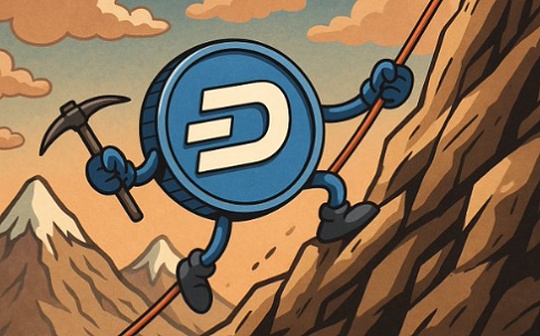
Author: Matthew Sigel, VanEck Digital Assets Director; Patrick Bush, VanEck Digital Assets Senior Investment Analyst; Translated by: 0xjs@Bitchain Vision
Before we start forecasting 2025, we take a moment to review VanEck’s forecast for 2024.Of the 15 forecasts made in December 2023, we gave ourselves 8.5/15 points.The 0.566 hit rate may not be perfect, but it’s enough to keep us moving forward.With Bitcoin breaking $100,000 and Ethereum breaking $4,000, even some of our mistakes are part of a memorable year.
Review of 2024 Crypto forecasts
1. Spot BTC ETP debut – (1 point)
2. Bitcoin halving progresses smoothly – (1 point)
3. Bitcoin hit a record high in the fourth quarter of 2024 – (1 point)
4. Ethereum is still ranked second behind Bitcoin – (1 point)
5. L2 leads Ethereum activity (but L2 TVL is still lower than Ethereum) – (0.5 points)
6. Stablecoin market value hits a record high – (1 point)
7. The proportion of spot trading volume on decentralized exchanges hits a record – (1 point)
8. SOL performs better than ETH-(1 point)
9. DePIN network adoption rate continues to grow – (1 point)
Now, let’s get to the point: VanEck’s cryptocurrency forecast for 2025.
Top 10 cryptocurrency forecasts in 2025
1. The cryptocurrency bull market reached its mid-term peak in the first quarter and hit a new high in the fourth quarter
2. The United States embraces Bitcoin through strategic reserves and increased adoption of cryptocurrency
3. Tokenized securities are worth more than US$50 billion
4. The daily settlement volume of stablecoins reaches US$300 billion
5. The AI agent has more than 1 million agents on-chain activities
6. The total lock value (TVL) of Bitcoin 2 layer reaches 100,000 BTC
7. Ethereum blob space generates $1 billion in fees
8. DeFi hit a record high, with DEX trading volume reaching US$4 trillion and TVL reaching US$200 billion
9. The NFT market recovers, trading volume reaches US$30 billion
10. DApp tokens narrow the performance gap with L1 tokens
1. The cryptocurrency bull market reached its mid-term peak in the first quarter and hit a new high in the fourth quarter
We believe the cryptocurrency bull market will continue until 2025 and reach its first peak in the first quarter.At the first peak of the cycle,We predict that Bitcoin price will be around $180,000, while Ethereum will be priced at more than $6,000.Other well-known projects, such as Solana (SOL) and Sui (SUI), may be over $500 and $10, respectively.
After the first peak, we expect BTC to see a 30% retracement, and altcoins will face a sharp decline of up to 60% as the market consolidates in the summer.However, there may be a recovery in the fall, with major tokens set to recover momentum and recover their previous all-time highs by the end of the year.To determine when the market is approaching its peak, we are monitoring the following key signals:
-
Continuously high funding rates: When traders borrow funds to bet on the rise in BTC prices, they are willing to pay more than 10% of the funding rates for three months or more, indicating over-speculation.
BTC futures funding rate for several months> 10% will be a bear market signal

Source: Glass Node, as of December 8, 2024.Past performance does not guarantee future results.It is not recommended to purchase or sell any of the securities mentioned herein.
-
Too much unrealized profit: If the proportion of BTC holders with a large amount of book income (profit to cost ratio is 70% or more) stabilizes, it means the market is hot.
-
Compared to realised value, market value is overvalued: When the MVRV (ratio of market value to realised value) scores more than 5, it indicates that the BTC price is much higher than the average purchase price, which usually indicates overheating.
-
Bitcoin’s dominance declines: If Bitcoin’s share of the entire cryptocurrency market falls below 40%, it means speculative shifts toward more risky altcoins, which is typical late-cycle behavior.
-
Mainstream speculation: A large number of text messages from friends who don’t understand cryptocurrencies asking suspicious projects are a reliable signal close to the top speculation fanaticism.
Historically, these indicators have been a reliable signal for market prosperity and will guide our outlook as we respond to the expected market cycle in 2025.

For example: A “Top Signal” text message sent by a friend I met five years ago.
2. The United States embraces Bitcoin through strategic reserves and increased adoption of cryptocurrency
Donald Trump’s election has injected huge momentum into the cryptocurrency market, with his administration appointing crypto-friendly leaders in key positions including Vice President JD Vance, National Security Advisor Michael Waltz, Commerce Secretary Howard Lutnick, FinanceMinister Mary Bessent, U.S. SEC Chairman Paul Atkins, Federal Deposit Insurance Corporation (FDIC) Chairman Jelena McWilliams, and Secretary of Health and Human Services RFK Jr.These appointments not only mark the end of anti-cryptocurrency policies, such as the systematic cancellation of banking of cryptocurrency companies and their founders, but also the beginning of a policy framework that positions Bitcoin as a strategic asset.
Cryptocurrency ETP: In-person creation, pledge and new spot approval
The new SEC leadership (or possibly the CFTC) will approve several new spot ETPs in the U.S., including VanEck Solana products.The Ethereum ETP functionality is extended to include staking, further enhancing its usefulness to holders, while both Ethereum and Bitcoin ETP support physical creation/redemption.Whether it is the U.S. SEC or Congress repealing SEC Rule SAB 121, it will pave the way for banks and brokers to custody spot cryptocurrencies, further integrating digital assets into traditional financial infrastructure.
Sovereign Bitcoin adoption: federal, state and mining expansion
We predict that by 2025, the federal government or at least one U.S. state (probably Pennsylvania, Florida, or Texas) will establish Bitcoin reserves.From a federal government perspective, this is more likely to be achieved by leveraging the executive order of the Treasury Foreign Exchange Stabilization Fund (ESF), although bipartisan legislation remains an unknown.Meanwhile, state governments may act independently to see Bitcoin as a tool to hedge fiscal uncertainty or to attract crypto investment and innovation.
In terms of Bitcoin mining, as the adoption rate of BRICS countries increases, the number of countries that use government resources to mine Bitcoin is expected to reach double digits (currently seven).Russia’s announcement of its intention to settle international trade in cryptocurrencies has further fueled this trend, highlighting Bitcoin’s growing importance in global economic strategy.
Number of countries that use government resources to mine Bitcoin

Source: VanEck Research, as of December 2024.
We expect this support for Bitcoin to spread to the entire U.S. crypto ecosystem.With regulatory clarity and incentives attracting talent and companies back, the global share of crypto developers based in the U.S. will rise from 19% to 25%.Meanwhile, Bitcoin mining in the United States will flourish, and the U.S. share of global mining computing power will rise from 28% in 2024 to 35% by the end of 2025, driven by cheap energy and potentially preferential tax policies..Together, these trends will consolidate the U.S. leadership in the global Bitcoin economy.
The share of Bitcoin computing power of listed companies in the United States will reach 35%
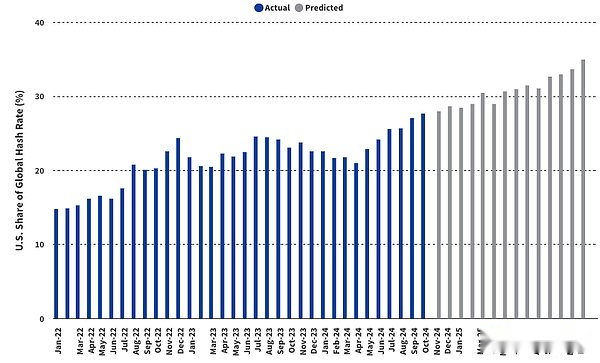
Source: JPMorgan Chase, VanEck Research data provided on December 6, 2024.Past performance does not guarantee future results.
Corporate Bitcoin Holdings are expected to soar 43%
In terms of enterprise adoption, we expect enterprises to continue to accumulate Bitcoin from retail investors.Currently, 68 publicly traded companies hold Bitcoin on their balance sheets, and we expect that this number will reach 100 by 2025.It is worth noting that we boldly predict that the total amount of Bitcoin held by private and public companies (currently 765,000 BTC) will exceed Satoshi’s 1.1 million BTC held next year.This means that corporate Bitcoin holdings will grow at an astonishing 43% growth rate in the coming year.
Gold and Bitcoin ownership: Business and government growth space
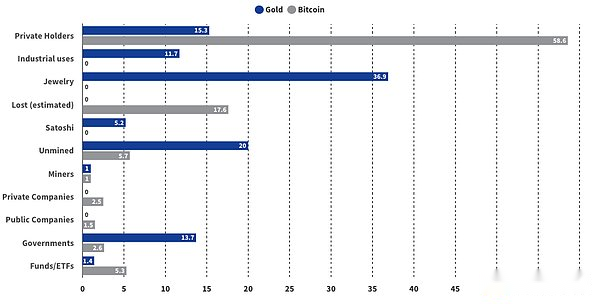
Source: VanEck Research, as of December 2024.
3. The value of tokenized securities exceeds US$50 billion
Onchain Securities grew 61% in 2024
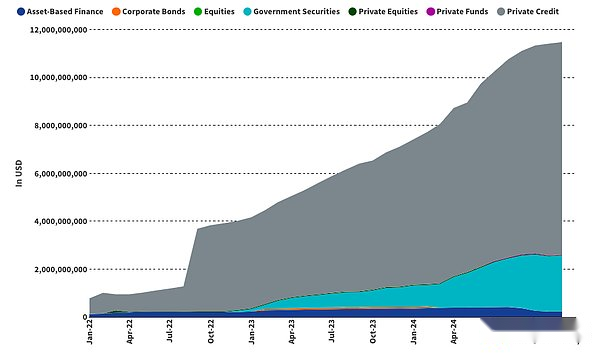
Source: RWA.xyz, Defilama, as of December 6, 2024.Past performance does not guarantee future results.
Crypto is expected to improve the financial system by increasing efficiency, decentralization and transparency.We believe 2025 will be the year for tokenized securities to take off.Currently, there are about $12 billion worth of tokenized securities on the blockchain, most of which ($9.5 billion) are tokenized private credit securities listed on Figure’s semi-licensed blockchain Provenance.
In the future, we see the huge potential of tokenized securities on public chains.We believe there are many incentives for investors to promote tokenized stocks or bonds to be issued exclusively on-chain.Next year, we expect entities like DTCC will enable tokenized assets to be seamlessly converted between public chains and private closed infrastructure.This dynamic will set standards for on-chain investors to implement AML/KYC.As an uncertainty, we predict that Coinbase will take unprecedented steps to tokenize COIN stocks and deploy them on its BASE blockchain.
4. The daily settlement volume of stablecoins reaches US$300 billion
Monthly stablecoin transfers (USD) increased by 180% year-on-year in 2024
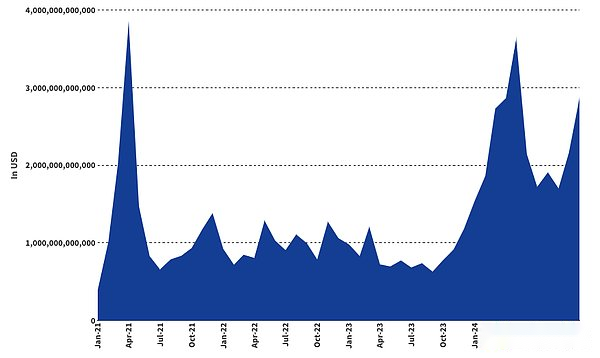
Source: Artemis XYZ as of December 6, 2024.Past performance does not guarantee future results.
Stablecoins will surpass their niche position in cryptocurrency trading and become a core part of global commerce.By the end of 2025, we expect stablecoins to settle US$300 billion in transfers per day, equivalent to 5% of the current transaction volume of DTCC, while the daily stablecoin settlement volume in November 2024 was approximately US$100 billion.Adoption of them by large tech companies (such as Apple and Google) and payment networks (Visa, Mastercard) will redefine payment economics.
In addition to transactions, the remittance market will also experience explosive growth.For example, stablecoin transfers between the United States and Mexico could grow 5 times, from $80 million a month to $400 million.What is the reason?Speed, cost savings, and the growing trust of millions of people, they no longer view stablecoins as experiments, but as practical tools.Although people are talking about blockchain adoption, stablecoins are its Trojan horse.
5. The AI agent has more than 1 million agents on-chain activities
AI agents’ total revenue in 5 weeks reached US$8.7 million
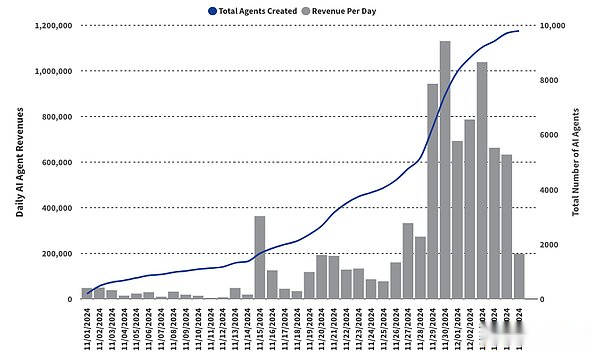
Source: Dune @jdhpyer as of December 6, 2024.Past performance does not guarantee future results
We believe that one of the most compelling narratives is the AI agent, which will translate into a huge attraction in 2025.AI agents are specialized artificial intelligence robots that guide users to achieve results such as “maximize benefits” or “stimulate X/Twitter participation”.Agents use their ability to automatically change strategies to optimize these results.AI agents are often input into data and trained to focus on one area.Currently, protocols like Virtuals provide anyone with tools to create AI agents to perform on-chain tasks.Virtuals allows non-experts to access decentralized AI agent contributors, such as fine-tuners, dataset providers, and model developers, so that non-technical personnel can create their own AI agents.The result will be a surge in the number of agents whose creators can rent out to generate income.
Currently, the focus of the construction of agents is DeFi, but we believe that AI agents will surpass financial activities.Agents can act as social media influencers, computer players in games, and interactive partners/assistants in consumer applications.Agents have become important X/Twitter influencers such as Bixby and Terminal of Truths, who have 92,000 and 197,000 followers, respectively.Therefore, we believe that the huge potential of agents will spawn over one million new agents in 2025.
6. The total lock value (TVL) of Bitcoin 2 layer reaches 100,000 BTC
The total number of Bitcoin L2 locked shares reached 30,000 BTC, up 600% so far in 2024
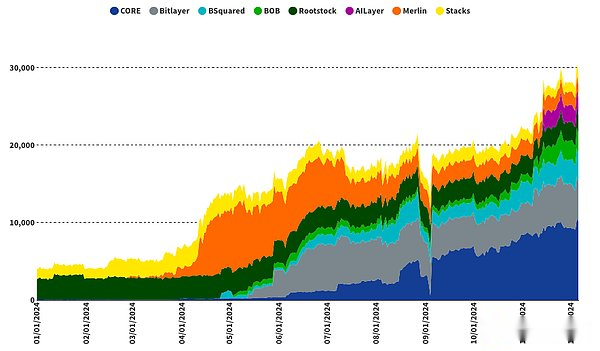
Source: Defilama as of December 6, 2024.Past performance does not guarantee future results.It is not recommended to purchase or sell any of the securities mentioned herein.
We are closely watching the emergence of Bitcoin L2 blockchains that have great potential to change the Bitcoin ecosystem.Extending Bitcoin allows these L2 solutions to achieve lower latency and higher transaction throughput, thus solving the limitations of the underlying layer.In addition, Bitcoin L2 enhances Bitcoin’s capabilities by introducing smart contract capabilities, which can power a powerful decentralized finance (DeFi) ecosystem built around Bitcoin.
Currently, Bitcoin can be transferred from the Bitcoin blockchain to smart contract platforms via bridged or wrapped BTC, which rely on third-party systems that are vulnerable to hackers and security vulnerabilities.The Bitcoin L2 solution is designed to address these risks by providing a framework that integrates directly with the Bitcoin base layer, minimizing dependency on centralized intermediaries.While liquidity restrictions and adoption barriers remain, Bitcoin L2 is expected to enhance security and decentralization, giving BTC holders more confidence to actively use their Bitcoin in a decentralized ecosystem.
As shown, the Bitcoin L2 solution experienced an explosive growth in 2024, with a total locked value (TVL) of over 30,000 BTC, a year-to-date growth of 600% to approximately $3 billion.Currently, more than 75 Bitcoin L2 projects are under development, but only a few are likely to achieve widespread adoption in the long run.
This rapid growth reflects a strong need for BTC holders to seek benefits and broader asset utility.As chain abstraction technology and Bitcoin L2 gradually mature into a product that can be used by end users, Bitcoin will also become an indispensable part of DeFi.For example, platforms such as Near Chain Abstraction used by Ika on Sui or Infinex highlight how innovative multi-chain solutions will enhance Bitcoin’s interoperability with other ecosystems.
By enabling secure and efficient on-chain lending and other permissionless DeFi solutions, Bitcoin L2 and abstract technologies will transform Bitcoin from a passive store of value to an active player in a decentralized ecosystem.As the scale of adoption expands, these technologies will bring huge opportunities to on-chain liquidity, cross-chain innovation and a more integrated financial future.
7. Ethereum blob space generates $1 billion in fees
Ethereum Blob released daily

Source: Dune @hildobby as of December 6, 2024.Past performance does not guarantee future results.
The Ethereum community is actively discussing whether Ethereum has gained enough value from its L2 network through Blob Space, a key component of its expansion roadmap.Blob Space acts as a dedicated data layer where L2 submits the compressed history of its transactions to Ethereum and pays ETH per blob.Although this architecture supports the scalability of Ethereum, L2 currently has extremely small value exported to the main network, with a gross profit margin of about 90%.This raises concerns that Ethereum’s economic value may be over-turned to L2, resulting in underutilization of the underlying layer.
Despite the recent slowdown in Blob Space growth, we expect its use to expand dramatically by 2025, mainly due to three key factors:
-
Explosive L2 adoption: Trading volume on Ethereum L2 grows at an annualized rate of over 300% as users move to low-cost, high-throughput environments for DeFi, gaming and social applications.As more and more transactions flow back to Ethereum for final settlement, the surge in consumer dApps on L2 will significantly increase the demand for blob space.
-
Rollup Optimization: Advances in Rollup technology, such as improved data compression and reduced cost of publishing data to Blob Space, will encourage L2 to store more transaction data on Ethereum, enabling higher throughput without sacrificing decentralization.
-
Introduction to high-fee use cases: The rise of enterprise-level applications, zk-rollup-driven financial solutions and real-world asset tokenization will drive high-value transactions, prioritizing security and immutability, and increasing willingness to pay for Blob Space fees.
By the end of 2025, we expect Blob Space to cost more than $1 billion, higher than currently negligible levels.This growth will strengthen Ethereum’s position as the ultimate settlement layer for decentralized applications, while enhancing its ability to acquire value from the rapidly expanding L2 ecosystem.Ethereum’s Blob Space will expand the network and become the main source of revenue, balancing the economic relationship between the mainnet and L2.
8. DeFi hit a record high, with DEX trading volume reaching US$4 trillion and TVL reaching US$200 billion
DeFi (Decentralized Finance) Total Locked Value (TVL)
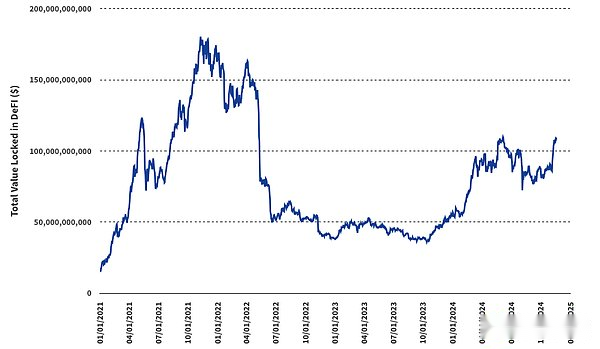
Source: Defilama as of December 6, 2024.Past performance does not guarantee future results.
Although the volume of decentralized exchanges (DEX) (both absolute and relative to centralized exchanges) hits record highs, the total locked value of decentralized finance (DeFi) remains24% lower than the peak.We expect DEX trading volume will exceed $4 trillion by 2025, accounting for 20% of CEX spot trading volume, driven by AI-related tokens and new consumer-facing dApps.
In addition, the influx of tokenized securities and high-value assets will boost DeFi growth, providing new liquidity and broader utility.Therefore, we expect DeFi TVL to rebound to over $200 billion by the end of the year, reflecting the growing demand for decentralized financial infrastructure in the evolving digital economy.
9. The NFT market recovers, trading volume reaches US$30 billion
NFT numbers decline in 2024; we expect a rebound in 2025
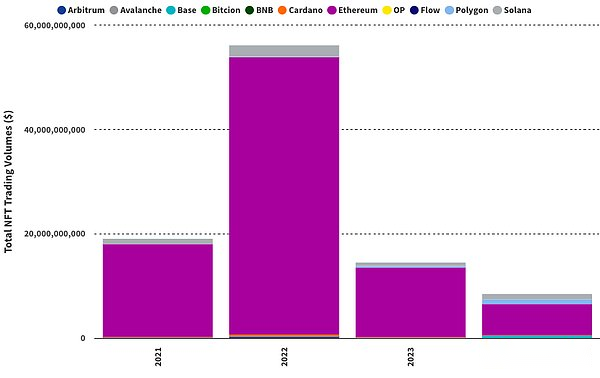
Source: As of: December 6, 2024.Past performance does not guarantee future results.It is not recommended to purchase or sell any of the securities mentioned herein.
The bear market from 2022 to 2023 has brought a heavy blow to the NFT industry, with trading volume plummeting 39% since 2023 and 84% since 2022.While the price of homogeneous tokens began to rebound in 2024, most NFTs lag behind, weak prices and inactive activity, and did not see a turning point until November.Despite these challenges, some outstanding projects have leveraged strong community ties to transcend speculative values and thus resisted downward trends.
For example, Pudgy Penguins has successfully transformed into a consumer brand through collecting toys, while Miladys has gained cultural status in the field of satirical online culture.Similarly, Bored Ape Yacht Club (BAYC) has been growing into a dominant cultural force, attracting widespread attention from brands, celebrities and mainstream media.
With the rebound of crypto wealth, we expect new wealthy users to invest in NFTs not just as speculative investments, but as assets with lasting cultural and historical significance.Given the strong cultural reputation and relevance of well-known collectibles such as CryptoPunks and Bored Ape Yacht Club (BAYC), they are likely to benefit from this transition.While BAYC and CryptoPunks are still well below their historical trading peaks, down about 90% and 66% respectively in ETH, other projects such as Pudgy Penguins and Miladys have already surpassed previous price highs.
Ethereum continues to dominate the NFT space, with most important collections.By 2024, it accounts for 71% of NFT transactions, and we expect that number to rise to 85% by 2025.This dominance is reflected in the market cap rankings, where Ethereum-based NFTs occupy all the top 10 and 16 of the top 20, highlighting the central role of blockchain in the NFT ecosystem.
While NFT trading volume may not return to the excitement highs of the previous few cycles, we believe that as the market turns to sustainability and cultural relevance rather than speculative speculation, an annual transaction volume of $30 billion is achievable., accounting for about 55% of the peak in 2021.
10. DApp token narrows the performance gap with L1 tokens
Layer 1 tokens perform 2 times better than leading dApps in 2024
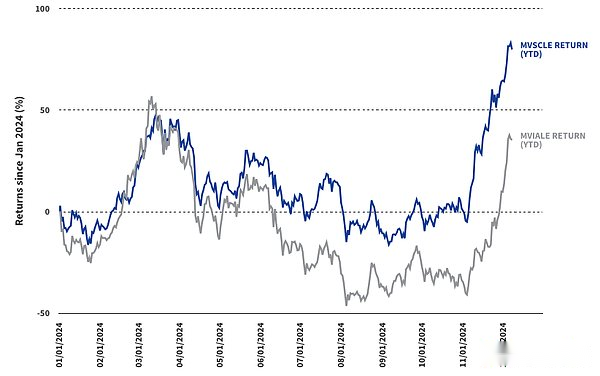
Source: Market Vectors as of December 8, 2024.Past performance does not guarantee future results.MVSCLE index tracking smart contract platform.MVIALE index tracks infrastructure application tokens.
A consistent theme in the 2024 bull market is that the L1 blockchain tokens perform significantly better than the decentralized application (dApp) tokens.For example, the MVSCLE index, which tracks smart contract platforms, has risen 80% so far this year, while the MVIALE index, which applies tokens, has returned only 35% in the same period, lagging behind.
However, we expect this dynamic to change later in 2024 as a new wave of dApps will be launched, offering innovative and practical products that bring value to their respective tokens.Among the main theme trends, we believe that AI is a prominent category of dApp innovation.In addition, the Decentralized Physical Infrastructure Network (DePIN) project has great potential to attract investors and users’ interest, helping to achieve a broader performance rebalancing between L1 tokens and dApp tokens.
This shift underscores the growing importance of practicality and product market fit to determine the success of application tokens in the evolving crypto field.

